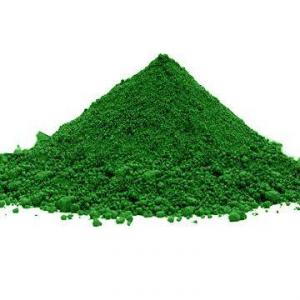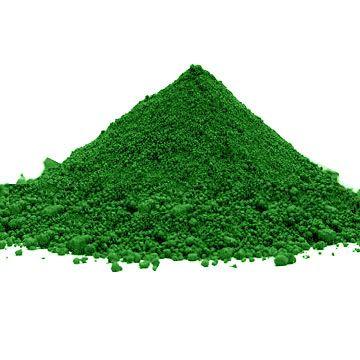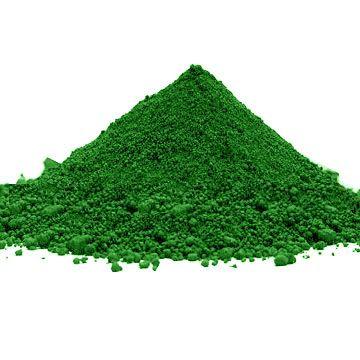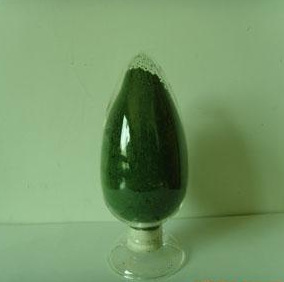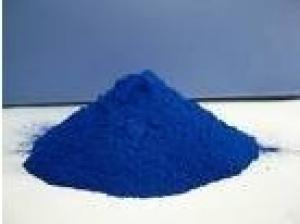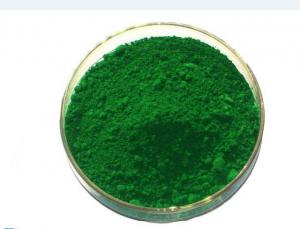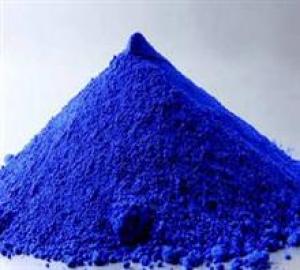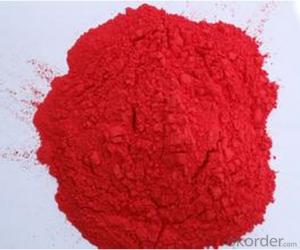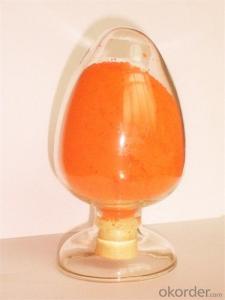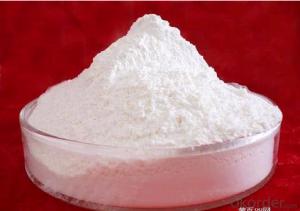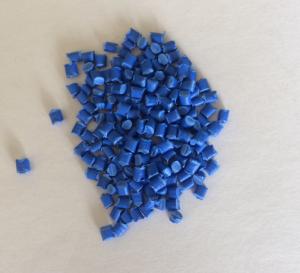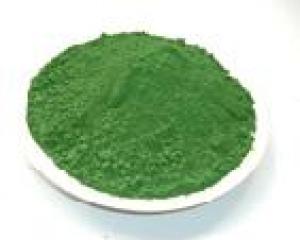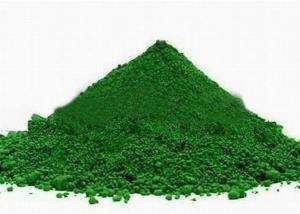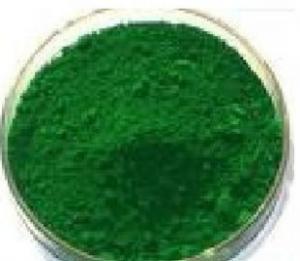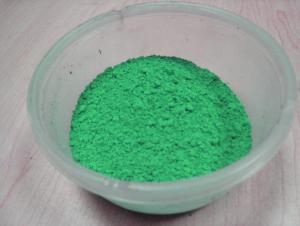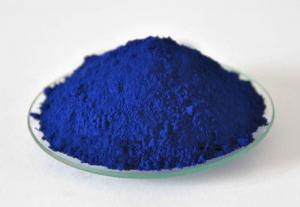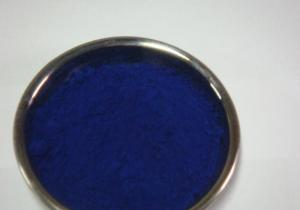Cr2O3 Chrome Oxide Green For Pigment
- Loading Port:
- Shanghai Port
- Payment Terms:
- TT or LC
- Min Order Qty:
- 1 Metric Ton m.t.
- Supply Capability:
- 8000MT Per Year m.t./month
OKorder Service Pledge
OKorder Financial Service
You Might Also Like
Production Details Of Chrome Oxide Green :
Molecular Formula: Cr2O3
HS Code: 2819900000
CAS No. : 1308-38-9
Appearance: green powder
Specifications: (Quality Standard: HG/T 2775-1996)
Packing Of Chrome Oxide Green :
25 kg/bag 20 MT/ 20 FCL or as your requirements .
Usage Of Chrom Oxide Green :
Mainly used in paint, glass, ceramics, building materials colorants, printing ink, metal polishing, smelting metal chromium, fire-proof material, etc.
Specifications: (Quality Standard: HG/T 2775-1996)
Pigment Grade:
Item | Index | ||
Excellent Grade | First Grade | Qualified Grade | |
Appearance | Green Power | ||
Color Reference | Same | ||
Relative Color Strength | Strength | ||
Density g/cm3 | 4.8 | ||
Cr2O3 | ≥ 99.0% | ≥ 98.0% | ≥ 97.0% |
Cr+6 ppm | ≤ 5 | ||
Soluble Chrome | ≤ 0.03% | ≤ 0.03% | ≤ 0.03% |
105°C Volatile Matter | ≤ 0.3% | ≤ 0.3% | ≤ 0.3% |
Water Soluble | ≤ 0.1% | ≤ 0.4% | ≤ 0.7% |
Moisture | ≤ 0.15% | ≤ 0.3% | ≤ 0.5% |
PH of Water Solution | 7—7.5 | ||
Oil Absorption (g/ 100g) | 17 | ||
Residue on Sieve of 0.045 mm | ≤ 0.1% | ≤ 0.3% | ≤ 0.5% |
1200℃ Ingition Decerement | 0.05 | ||
Acid& Alkali Resistance | 5 | ||
Temperature Stability | 1000 | ||
Weather Fastness | 5 | ||
Ceramic Grade:
Item | Index | ||
Excellent Grade | First Grade | Qualified Grade | |
Cr2O3 | ≥ 99.0% | ≥ 98.0% | ≥ 97.0% |
Soluble Chrome | ≤ 0.03% | ≤ 0.03% | ≤ 0.03% |
105°C Volatile Matter | ≤ 0.3% | ≤ 0.3% | ≤ 0.3% |
Water Soluble | ≤ 0.1% | ≤ 0.4% | ≤ 0.7% |
Moisture | ≤ 0.15% | ≤ 0.3% | ≤ 0.5% |
PH of Water Solution | 6-8 | 5-8 | 5-8 |
Oil Absorption (g/ 100g) | 15-25 | 15-25 | 15-25 |
Residue on Sieve of 0.045 mm | ≤ 0.1% | ≤ 0.3% | ≤ 0.5% |
Relative tinting strength | Comply with the requirements | ||
Chroma | Comply with the requirements | ||
Refractory Grade:
Item | Index | ||
Excellent Grade | First Grade | Qualified Grade | |
Cr2O3 ≥ | 99% | 98% | 97% |
Moisture ≤ | 0.15 | 0.3 | 0.5 |
Water Soluble ≤ | 0.1 | 0.4 | 0.7 |
Igloss ≤ | 0.6 | --- | ---- |
Metal Grade: Quality Standard:(ROCT 2912—79)
Grade | OXM-0 | OXM-1 | Grade | OXM-0 | OXM-1 |
Appearance | Green Power | (Zn)/% ≤ | 0.002 | ||
Cr2O3/% ≥ | 99 | 98 | (Sb)/% ≤ | 0.003 | |
Moisture/% ≤ | 0.10 | 0.15 | (Bi)/% ≤ | 0.003 | |
(S)/% ≤ | 0.01 | 0.02 | (Sn)/% ≤ | 0.003 | |
Fe、FeO/% ≤ | 0.1 | 0.15 | (Pb)/% ≤ | 0.002 | |
(C)/% ≤ | 0.03 | 0.05 | (Cd)/% ≤ | 0.003 | |
(As)/% ≤ | 0.002 |
|
| ||
Abrasive Grade: Quality Standard( ROCT 2912—79)
Grade | OXA-0 | OXA-1 | OXA-2 |
Appearance | Green Power | ||
Cr2O3/% ≥ | 99 | 99 | 98 |
Moisture/% ≤ | 0.15 | 0.15 | 0.15 |
Water Soluble/% ≤ | 0.2 | 0.2 | 0.5 |
Polishing Force/[mg/(min.cm2)] ≥ | 0.2 | 0.1 | 0.3 |
Polished Surface Roughness/μm ≤ | 0.100 | 0.20 | 0.80 |
Note: At present in China, the abrasive standard without grinding performance standards, which cannot be grinding and polishing performance evaluation. But according to your needs or our experience to agreed.
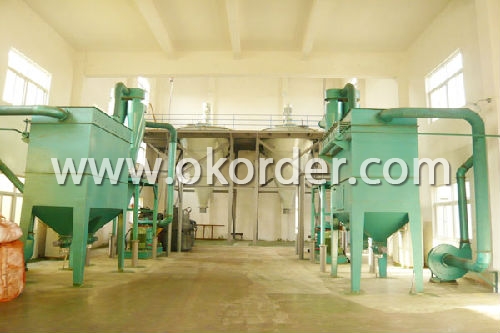
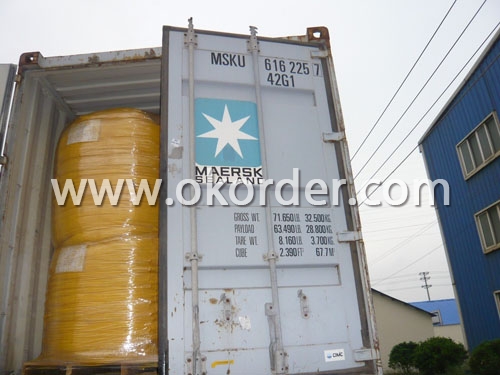
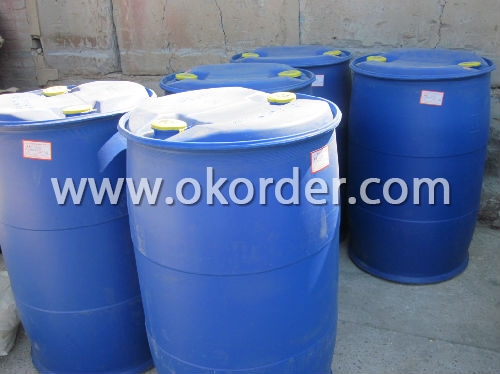
- Q: I need to find powdered paint or pigment that I can throw, for some photographs.Preferably cheap, and that wouldn't stain skin.I've looked into powder paint, though this tends to stain skin for about a week.Thanks :)
- There are diverse varieties of eyeshadows, which means diverse finishes. Matte, working example, would be very, very centred interior the colour, wherein as a lustre will reveal up sheer, and additionally you will possibly be able to barley get any precise pigment out of it. MAC paint is for a base, or primer on your eye lids, which means you will possibly be able to placed that on until now you place any eye liner, shadow, pigment, etc. based on the colour paint you make the main of, it would strengthen or tone down and eye shadow or pigment then you definately definately challenge on the lid. Pigment is a very, very centred loose powder. You superb want a tiny, tiny pinch of it, and the containers they arrive in, circulate a verrrry sturdy distance. The purpose persons customarily use pigments as a shadow alternative, may be in view that the the two MAC does now not deliver the precise colour of the paticular pigment in a shadow, or they are applying it to extend shadows, or finally, they are mixing it with shadows to create diverse colors. desire that's assisting.
- Q: Why do algae contain pigments other than just chlorophyll?
- they stay underwater...the water swollows easy in a definite sequence, so the deeper they stay the greater distinctive is the easy and that they elect different pigments than landplants.
- Q: do all leaves extract contain the same pigments??why?
- Plants okorder /... Plants have classes of pigments that act as adjuncts to the chloroplast's chlorophyll, in several ways. Some are accessory pigments that broaden the range of absorbed light. These pigments are found in the light gathering arrays in chloroplasts. They also alter the color of the leaf depending on what specific pigments it has to gather light energy and that determines what is reflected (green is the basic reflected spectra but is might be yellowish or bluish green). The major accessory class of pigments, the carotenoids, collect light in the red to yellow wavelengths chlorophyll a can’t, then the carotenoids transfer the energy to chlorophyll a to process. Among the carotenoids are the xanthophylls that provide UV protection for the light gathering centers of the chloroplast. Plants adapt to situations and some just have fewer chloroplasts so have less chlorophyll and absorb less of the light. In low light situations they need fewer so variegated plants are possible. This reduced chlorophyll level allows small amounts of other pigments like the yellow pigment xanthophyll to show up.
- Q: A.catalyzes chemical reactions.B.absorbs light.C.transports materials.D nverts energy to light.E s energy.
- B. It absorbs light.
- Q: (Explain what happens when a pigment molecule is struck by electromagnetic radiation in the visible light spectrum.)
- pigments are molecules that absorb electromagnetic radiation. For example, the chlorophyll pigment in plants absorbs blue and red light, which is why they reflect green light (since green is the color not absorbed). Another example is melanin, which is the pigment that darkens the skin of people. Melanin absorbs UV to protect the skin. A pigment molecule struck by EM radiation in the visible region may absorb some of the light depending on what pigment it is.
- Q: what pigment are? give two example
- pigments found in plants, vegetables and fruits, make them look colorful. pigments found in animal skins, givie us colorful animal skins with variety of shades. Plant pigment Chlorophyll makes plant leaves look green. Plant pigment Carotenoid makes fruits and vegetables look orange, yellow, red. Plant pigment Phycobilin makes plants look bluish green or red.
- Q: what the book says is that they 'harvest additional wavelengths.' i don't know what this means to how its an advantage.. can somone explain?
- in leaves accesory pigments are important because chlorophyll the main plants pigment are easilly broken down by low temperature. if chlorophyll, the green pigmnet is broken down accesory pigments give the leaves its color, usually orange, yellow
- Q: how are the pigments in clothes differ from plant pigments?
- Pigments are pigments. They are made of molecules that absorb some colors and reflect others from the visible spectrum of light, which gives everything color. Black pigments absorb everything and reflect nothing, so black is the absence of color and it is why dark clothing are warmer in winter. White pigments reflect everything and absorb nothing, so clothing that is white is cooler in summer. Most plants have more chlorophyll, a green pigment, in them than other pigments, so the plant is overwhelmingly reflecting green back to our eyes and absorbing the red and blue ends of the spectrum. In fall, when the chlorophyll breaks down, we can see the yellow, orange, and red pigments that are also in the leaf for a few weeks. In this way, all pigments are alike. However, perhaps what your teacher is looking for is that the green pigment chlorophyll in plants not only absorbs red and blue wavelengths of light, it also uses that energy to excite electrons from the molecules of chlorophyll and send them through an electron transport chain that enables light energy to be converted to chemical energy and store it in the C-H bonds of glucose, which is made during photosynthesis. Other pigments, whether they be in clothes or other objects such as cars or just about anything else do not do this. Only plant chlorophyll, or the green pigment in plants, converts light energy to chemical energy. That is the one huge difference. Otherwise, like all other pigments, chlorophyll absorbs some wavelengths of light and reflects others, in the case of chlorophyll, green wavelengths of light.
- Q: i bought the new neon pro pigments from mac , well 5 out of the six and i also bought 'basic red'i want to use these as eye shadows but i dont know howi also bought mac mixing medium for face and body but lol , i dont know how to use any of this stuffwhat can i do to use this stuff i mean will it turn out like regular eyeshadow if i use it right? will there be a shine to it? it will reduce fall out? should i put the mixing medium on my eye first , then let dry?do i need to possibly press the pigments in a pot with some kind of eye shadow liquid?i also bought the mascara mixing medium but want to know exactly what to do with thatand also , can i mix any of the pigments with lipgloss?http://cn1.kaboodle /hi/img/2/0/0/119/a/AAAAAlrx1LUAAAAAARmgiA.jpg
- look on youtube they have all the answers!
- Q: Can somebody answer this in AP BIO language please
- A pigment molecule absorbs at specific wavelength(s), meaning that when light of a specific wavelength is incident to the molecule only certain wavelengths are absorbed while others are transmitted. The spectrophotometer emits monochromatic light (light of only one wavelength) which passes through the pigment molecule and a detector determines the amount of light that is either absorbed or transmitted by the sample. This is done at wavelengths from the UV (180-330 nm) to the visible (330-700 nm) and the light that is either transmitted or absorbed is detected by the spectrophotometer and is able to be graphed with absorbance representing the y-axis and wavelength representing the x-axis. The resultant graph will depict the absorption spectrum of that particular pigment molecule. Hope that helps.
1. Manufacturer Overview
| Location | Liaoning, China |
| Year Established | 1960 |
| Annual Output Value | Above US$ 100 Million |
| Main Markets | 20.00% North America 20.00% South Asia 10.00% Middle East 10.00% North America 10.00% Northern Europe 10.00% South Asia 10.00% Western Europe 5.00% Africa 5.00% Eastern Europe |
| Company Certifications | ISO9001:2000 |
2. Manufacturer Certificates
| a) Certification Name | |
| Range | |
| Reference | |
| Validity Period |
3. Manufacturer Capability
| a) Trade Capacity | |
| Nearest Port | Dalian Port |
| Export Percentage | 41% - 50% |
| No.of Employees in Trade Department | 10-20 People |
| Language Spoken: | English; Chinese; |
| b) Factory Information | |
| Factory Size: | Above 10,000 square meters |
| No. of Production Lines | Above 6 |
| Contract Manufacturing | design and manufacture service offered. |
| Product Price Range | High; Average |
Send your message to us
Cr2O3 Chrome Oxide Green For Pigment
- Loading Port:
- Shanghai Port
- Payment Terms:
- TT or LC
- Min Order Qty:
- 1 Metric Ton m.t.
- Supply Capability:
- 8000MT Per Year m.t./month
OKorder Service Pledge
OKorder Financial Service
Similar products
Hot products
Hot Searches
Related keywords


